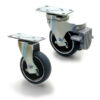Are Touchscreen Kiosks The Future Of Shopping?
When is the last time you used a touchscreen kiosk? If you are like most North Americans, it was within the last couple of days. Over the past thirty years, kiosks have quietly reshaped large segments of modern life, and have had such a profound impact on the 21st century landscape it is hard to remember a time when banking wasn’t dominated by ATMs, or airports by self-service check-ins.

With high quality touchscreen technology widely available and customer demand for self-serve options on the rise, kiosks exist in the sweet spot between affordability, functionality, and customer comfort. Among the many applications for touchscreen technology that are reshaping how we interface with machines, sales kiosks are one of the most pervasive. Whether ordering a burger and fries at a fast food restaurant, picking up photo prints at a Walmart, or buying a train ticket, retail kiosks are changing how we shop. And for those in the industry, these innovations have led to serious profits: according to Business Wire, by 2020 the service kiosk market is expected to be worth $18 billion USD, and much of this growth is being driven directly by the retail sector.
In 2015, retail accounted for 45% of all sales through kiosks, followed by entertainment (27% of all sales) and travel (11%). These numbers suggest that when it comes to a significant number of purchases, many North Americans are attracted by the convenience and flexibility for which kiosk shopping allows. Just as most of us are far more likely to get cash from an ATM than a bank teller, it seems many of us would also prefer to order our fast food from a kiosk rather than a person.
There are still questions about whether or not kiosks will ever completely replace human cashiers. In some sectors, like the supermarket industry, kiosks play a primarily supportive role, helping outlets process customers faster and lowering the overhead by reducing the number of floor staff needed. With the presence of more touch screen kiosks, keeping on top of sanitizing touch points including these screens and other areas such as door handles and surfaces, has become important in many day-to-day business practices. Many businesses will even hire professionals that provide commercial cleaning in Acheson, or in their local area to ensure that these cleaning needs are met to a high standard.
For industry insiders looking for ways to make brick-and-mortar retail more viable, kiosk design is one of the most promising areas of development. With touchscreen providers like Ontario’s A D Metro offering specialized service and cutting-edge new products, building new, effective kiosks is easier than ever. And as they grow to dominate more and more sectors of the retail economy, it is not a question of if kiosks will become standard, but when.
So, is the day coming when all our shopping transactions will take place through touchscreens or on the Internet? At this point, it is impossible to say. But what does seem clear is that whatever the immediate future has in store, it probably involves kiosks — lots of them. Developers looking to tap into this exciting new market should consider how partnering with touch screen providers can help them create the next hot kiosk application.










